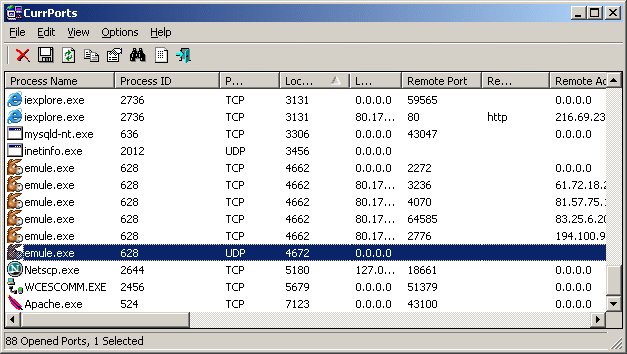Irgendwie ist die Aktivität mit svchost.exe bei mir gestiegen 
Also kam ich nicht um diese ätzende Arbeit der Regeleingabe herum...
Erlaube DHCP
Protokoll: UDP
Lokaler Port: 68
Remote Port: 67
Verbindungsrichtung: Ankommend
Aktion: AllowIt
Erlaube DNS
Protokoll: UDP
Lokaler Port: 53
Aktion: Erlaubt
Erlaube Time Synchronizer Verbindung
Protokoll: UDP
Remote Port: 123
Aktion: Erlaubt
Erlaube HTTP Verbindung
Protokoll: TCP
Remote Port: 80
Verbindungsrichtung: Ausgehend
Aktion: Erlaubt
Erlaube HTTPS Verbindung
Protokoll: TCP
Remote Port: 443
Verbindungsrichtung: Ausgehend
Aktion: Erlaubt
Erlaube TCP für Router (falls vorhanden)
Protokoll: TCP
Remote Host: IP des Routers
Verbindungsrichtung: ausgehend
Aktion: AllowIt
Erlaube UDP für Router (falls vorhanden)
Protokoll: UDP
Remote Host: IP des Routers
Aktion: AllowIt
Blockiere "SSDP Discovery Service" und "UPnP device Host" Services
Protokoll: UDP
Remote Port: 1900
Remote Host: 239.255.255.250
Aktion: Blockiert
Blockiere "SSDP Discovery Service" und "UPnP device Host" Services
Protokoll: TCP
Remote Port: 5000
Remote Host: 239.255.255.250
Verbindungsrichtung: Ankommend
Aktion: Blockiert
Blockiere "SSDP Discovery Service" und "UPnP Device Host" Services
Protokoll: UDP
Remote Port: 5000
Remote Host: 239.255.255.250
Aktion: Blockiert
Als letzte Regel sollte eine "Block All" Regel alle weiteren Verbindungen blockieren:
Blockiere TCP ausgehend
Protokoll: TCP
Lokaler Port: 135
Verbindungsrichtung: Ausgehend
Aktion: Blockiert
Blockiere TCP ankommend
Protokoll: TCP
Lokaler Port: 135
Verbindungsrichtung: ankommend
Aktion: Blockiert
Blockiere UDP ausgehend
Protokoll: UDP
Lokaler Port: 135
Verbindungsrichtung: Ausgehend
Aktion: Blockiert
Blockiere UDP ankommend
Protokoll: UDP
Lokaler Port: 135
Verbindungsrichtung: ankommend
Aktion: Blockiert
Gruss
Tim
Also kam ich nicht um diese ätzende Arbeit der Regeleingabe herum...
Erlaube DHCP
Protokoll: UDP
Lokaler Port: 68
Remote Port: 67
Verbindungsrichtung: Ankommend
Aktion: AllowIt
Erlaube DNS
Protokoll: UDP
Lokaler Port: 53
Aktion: Erlaubt
Erlaube Time Synchronizer Verbindung
Protokoll: UDP
Remote Port: 123
Aktion: Erlaubt
Erlaube HTTP Verbindung
Protokoll: TCP
Remote Port: 80
Verbindungsrichtung: Ausgehend
Aktion: Erlaubt
Erlaube HTTPS Verbindung
Protokoll: TCP
Remote Port: 443
Verbindungsrichtung: Ausgehend
Aktion: Erlaubt
Erlaube TCP für Router (falls vorhanden)
Protokoll: TCP
Remote Host: IP des Routers
Verbindungsrichtung: ausgehend
Aktion: AllowIt
Erlaube UDP für Router (falls vorhanden)
Protokoll: UDP
Remote Host: IP des Routers
Aktion: AllowIt
Blockiere "SSDP Discovery Service" und "UPnP device Host" Services
Protokoll: UDP
Remote Port: 1900
Remote Host: 239.255.255.250
Aktion: Blockiert
Blockiere "SSDP Discovery Service" und "UPnP device Host" Services
Protokoll: TCP
Remote Port: 5000
Remote Host: 239.255.255.250
Verbindungsrichtung: Ankommend
Aktion: Blockiert
Blockiere "SSDP Discovery Service" und "UPnP Device Host" Services
Protokoll: UDP
Remote Port: 5000
Remote Host: 239.255.255.250
Aktion: Blockiert
Als letzte Regel sollte eine "Block All" Regel alle weiteren Verbindungen blockieren:
Blockiere TCP ausgehend
Protokoll: TCP
Lokaler Port: 135
Verbindungsrichtung: Ausgehend
Aktion: Blockiert
Blockiere TCP ankommend
Protokoll: TCP
Lokaler Port: 135
Verbindungsrichtung: ankommend
Aktion: Blockiert
Blockiere UDP ausgehend
Protokoll: UDP
Lokaler Port: 135
Verbindungsrichtung: Ausgehend
Aktion: Blockiert
Blockiere UDP ankommend
Protokoll: UDP
Lokaler Port: 135
Verbindungsrichtung: ankommend
Aktion: Blockiert
Gruss
Tim

